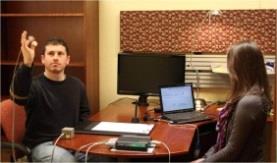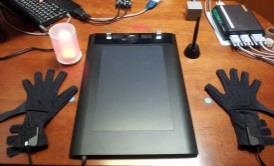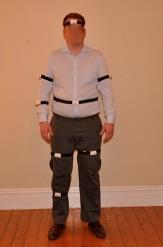ELEC01 - Automatic Diagnosis and Monitoring of Neurodegenerative Diseases
Submitting Institution
University of YorkUnit of Assessment
Electrical and Electronic Engineering, Metallurgy and MaterialsSummary Impact Type
TechnologicalResearch Subject Area(s)
Mathematical Sciences: Applied Mathematics
Engineering: Electrical and Electronic Engineering
Medical and Health Sciences: Neurosciences
Summary of the impact
Bio-inspired computer algorithms, developed by Dr Stephen Smith at the
University of York, have been integrated with commercially available
hardware that analyse patients' movements to diagnose and monitor a range
of neurodegenerative conditions including Parkinson's disease and
Alzheimer's disease. Clinical studies undertaken in the UK and USA report
a diagnostic accuracy exceeding 90% - a 15% improvement on current
clinical practice. A new spinout company, ClearSky Medical Diagnostics
Ltd, has licenced four products exploiting this technology to nine health
centres in the UK, USA, Singapore, Australia and UAE, transforming
clinical testing with improved diagnosis and monitoring of patients in
hospitals and their own homes.
Underpinning research
Existing approaches to the diagnosis and monitoring of neurodegenerative
(brain) disorders are very subjective, relying on a clinician's
measurement against a rating scale and, occasionally, costly brain scans.
Research undertaken by Dr Smith seeks to overcome these problems by
employing a novel non-invasive task-based approach.
The underpinning research comprises two biologically inspired algorithms:
Implicit Context Representation Cartesian Genetic Program (IRCGP) and
Artificial Biochemical Networks (ABNs).
IRCGP is an evolutionary algorithm developed in 2005 by Smith (Senior
Lecturer in Electronics since 2003). Its advantages over traditional forms
of evolutionary algorithms, based around its implicit context
representation, have been reported in a series of investigations conducted
by Smith's group [1]. The use of these algorithms to reliably diagnose
Parkinson's Disease patients demonstrated by Smith in clinical studies
undertaken at the Royal Liverpool and Broadgreen Hospitals in 2007 [2-3]
and at Leeds General Infirmary in 2011[4], has transformed the
conventional clinical "finger-tapping test", revealing microscopic
movements in Parkinson's patients that are invisible to the naked eye.
ABNs are a class of computational architectures inspired by the function
and organisation of biochemical networks. ABNs were developed at York from
2008-13 as part of the EPSRC AlBiNo project [5] and can be coupled to
complex dynamical systems, performing difficult computational behaviors
such as control and classification [5]. When combined with IRCGP these
algorithms can discriminate between Parkinson's disease patients and
age-matched controls with accuracies exceeding 90% - a significant
improvement on existing diagnosis of 75% [6].
These biologically inspired algorithms have been integrated with
commercially available hardware such as electromagnetic tracking sensors,
accelerometers, high performance data gloves and digitizing tablets to
record over 100 patients' movements in detail as they perform a variety of
conventional clinical tasks. The result is a technology that facilitates
measurement of a host of patient groups, including Parkinson's disease,
Alzheimer's disease, Progressive Supranuclear Palsy, Multiple System
Atrophy and Frontal Temporal Dementia.
This research improves on previous technologies in two important ways:
(i) The biologically inspired algorithms have been trained to
differentiate between neurodegenerative conditions with a higher degree of
accuracy than can be achieved using traditional signal processing
algorithms or conventional clinical evaluation and are less susceptible to
variations in patients' motor function ability.
(ii) Integrating low cost, commercially available wireless sensors,
permits diagnosis and monitoring to be taken out of the laboratory and
into conventional clinical settings such as hospital day clinics and the
patient's home, exploiting telemedicine to facilitate reliable and
immediate communication.
These advancements have made the technology particularly suitable for use
in routine diagnosis and monitoring of patients, the evaluation of new
drugs and therapies. It led to the award of a Royal Academy of Engineering
Enterprise Fellowship to Smith in April 2013 to launch ClearSky Medical
Diagnostics Ltd. and commercialise the technology.
References to the research
[1] "Benefits of Employing an Implicit Context Representation on Hardware
Geometry of CGP," X. Cai1, S. L. Smith1 and A. M.
Tyrrell1, Lecture Notes in Computer Science. Vol. 3637,
143-154, 2005. (Available on request)
[2] "Diagnosis of Parkinson's Disease using Evolutionary Algorithms," S.
L. Smith1, P. Guaghan1, Q. Du, N. M. Aly2,
J. R., Playfer2, D. M. Halliday1, Genetic
Programming and Evolvable Machines, Vol.8, 433-447, 2007. DOI:
10.1007/s10710-007-9043-9
[3] "An Immune Network Inspired Evolutionary Algorithm for the Diagnosis
of Parkinson's Disease," S. L. Smith1 and J. Timmis1,
BioSystems, Vol. 94, Nos.1-2, 2008. DOI: 10.1016/j.biosystems.2008.05.024
[4] "How Slow is Too Slow? Objective Measurement of Bradykinesia in
Parkinson's Disease using Novel Non-invasive Devices," J. E. Alty2,
D. R. S. Jamieson2, M. A. Lones1 and S. L. Smith1,
Proc. Int. Congress on Parkinson's Disease and Movement Disorders, Mov
disord 27, Suppl. 1, S91-S92, 2012. (Available on request)
[5] "Artificial Biochemical Networks: Evolving Dynamical Systems to
Control Dynamical Systems," M. A. Lones1, L. A. Fuente1,
A. P. Turner1, L. S. D. Caves1, S. Stepney1,
S. L. Smith1 and A. M. Tyrrell1, IEEE Transactions
on Evolutionary Computation, doi: 10.1109/TEVC.2013.2243732, 2013. DOI:
10.1109/tevc.2013.2243732
[6] "Evolving Classifiers to Recognise the Movement Characteristics of
Parkinson's Disease Patients," M. A. Lones1, S. L. Smith1,
J. E. Alty2, S. Lacy1, K. L. Possin2, D.
R. S. Jamieson2 and A. M. Tyrrell1, IEEE
Transactions on Evolutionary Computation, doi:10.1109/TEVC.2013.2281532,
2013. DOI: 10.1109/TEVC.2013.2281532
1University of York,
2Clinical collaborators
J. E. Alty and D. R. S. Jamieson are consultant neurologists at Leeds
General infirmary.
N. M. Aly and J. R., Playfer were formerly consultant geriatricians at
the Royal Liverpool and Broadgreen Hospitals.
K. L. Possin is a clinical psychologist at the University of California
San Francisco Memory and Aging Center.
IEEE Transactions on Evolutionary Computation is the preeminent journal
for evolutional computation with an impact factor of 4.81.
The International Congress on Parkinson's Disease and Movement Disorders
is the leading medical conference in this area.
Details of the impact
The biologically inspired computer algorithms, developed by Smith and
colleagues at the University of York, have led to the creation of four
products for the medical devices market.
PDMD — Objective Diagnosis of Parkinson's Disease
(Protected by patent application PCT/GB12/050093)
This novel non-invasive device, currently installed in hospitals in the
UK [7], USA [8,9], UAE [10] and Australia [11], confirms diagnosis of
Parkinson's Disease by digitally measuring patients performing a simple
finger tapping test used in conventional clinical evaluation. This allows
microscopic movements, invisible to the human eye, to be identified that
characterise the symptoms of Parkinson's disease in a way that has not
previously been possible.

NDMD — A Unified Test for Neurodegenerative Disorders
(Protected by patent application PCT/GB12/050093)
This technology provides the means by which Parkinson's disease can be
differentiated from other neurodegenerative conditions, such as
Alzheimer's disease and Lewy Body Dementia, at a stage when symptoms are
often confused and a conventional diagnosis is difficult to obtain. The
test, which is currently in use in hospitals in the UK [7], USA [8,9] and
UAE [10], can be undertaken quickly and safely, providing instantaneous
feedback to health staff.

LIDMD — Recognition and Monitoring of Levodopa-induced Dyskinesia
(Protected by patent application PCT/GB13/051888)
This system is being used by Leeds General Infirmary [7] to monitor
Parkinson's disease patients in their own homes and inform administration
of their medication. The most effective form of treatment for Parkinson's
Disease symptoms is a drug called levodopa, but approximately 90% of
patients who take it for ten years or more develop severe side effects
including involuntary movements called dyskinesia, a major source of
disability severely affecting the patient's quality of life. In
conventional practice, physicians rely on patients' own descriptions or,
in severe cases, patients are admitted to hospital for several days, to
monitor symptoms and adjust their medication accordingly. This system
provides an objective measure of dyskinesia over extended time periods
permitting a better informed course of medication, thereby reducing
unplanned hospital admissions, consultations and greatly improving the
patient's quality of life.

CFMD — Computer-Assisted Marking of the Benson Figure Test
(Protected by patent application PCT/GB13/051889)
The Benson Figure Test is used throughout the United States to asses
decline in visuo-spatial ability, an important symptom of Alzheimer's
disease. However, conventional scoring of patients' responses is
subjective and therefore lacks sensitivity. Biologically inspired
algorithms have been used at the UCSF [8] and VA Medical Centers [9] to
analyze the dynamic characteristics of patients' pen movements during the
drawing process. This provides additional objective measures that are
better able to detect mild impairment than the conventional scoring
systems, permitting an earlier and more secure diagnosis.

These products have had significant impacts in the following areas:
i) Routine clinical assessment of neurodegenerative (brain) disorders
Clinical studies at the Royal Liverpool and Broadgreen Hospitals in 2007,
Leeds General Infirmary in 2010 (NHRES 08/H0903/36) and 2012 (NHRES
10/H1308/5) demonstrated PDMD improves diagnostic accuracy for Parkinson's
Disease from 75% to over 90% [7]. Further studies at the University of
California, San Francisco, Memory and Aging Center (UCSF MAC) in 2012
(NIH/NIA K23 AG037566-01A1) [8] and the Veteran's Affairs Medical Center
in San Francisco (SFVA) in 2012 (Michael J. Fox Foundation) [9]
demonstrated that NDMD can be used to monitor other neurological
conditions such as Huntington's disease and Progressive Supranuclear
Palsy, "The methods of assessment enabled by this technology are unique
and provide an unrivaled means to investigate these conditions" said Dr
Schuff, Professor of Radiology, Veterans Affairs Medical Center, San
Francisco [9].
In 2013 the technology was licensed for use in additional hospitals
worldwide including the Rashid Hospital, Dubai [10], Monash Medical
Centre, Melbourne, Australia [11], the University of Washington School of
Medicine and the National Neuroscience Institute in Singapore.
ii) Monitoring the effectiveness and side effects of prescribed
medication
Following a successful clinical study at Leeds General Infirmary in 2011
and 2012 (NRES 11/NW/0541), the technology is now being used to monitor
Parkinson's disease patients in their own homes [7]. Parkinson's UK has
estimated savings of £270,000 per year for each specialist nurse employed
to oversee home care for patients [12] and introduction of this technology
enables these nurses to undertake objective measurements which can be
instantly relayed to consultants, freeing up their time whilst maintaining
close monitoring of their patients' condition. "For the first time, this
technology provides objective, reliable measurements that can be easily
assessed by health professionals to inform management of patients with
Parkinson's disease. Real benefits, such as reducing specialist
consultations, hospital admissions and time spent in hospital can now be
realised" says Dr Jamieson, consultant neurologist at Leeds General
Infirmary [7].
iii) Commercialization through a spinout company
ClearSky Medical Diagnostics Ltd. [13] is a new (2013) University of York
spinout company set up to exploit this technology through four products
described above, providing quick, safe and reliable means of diagnosis and
monitoring of patients in the hospital clinic and their own homes.
Currently employing one full time and five part-time staff, the company is
in the process of fully commercialising the products ready for worldwide
sale.
Sources to corroborate the impact
[7] Dr Stuart Jamieson MA, MBChB, PhD, FRCP — Consultant Neurologist,
Leeds General Infirmary, UK.
[8] Dr Katherine L. Possin, Ph.D. — Clinical Psychologist, Memory and
Aging Center, University of California San Francisco, USA.
[9] Dr Norbert Schuff, Ph.D. — Professor of Radiology, Veterans Affairs
Medical Center, San Francisco, USA.
[10] Dr Yasir Mehmood Malik — Neurologist, Rashid Hospital, Dubai.
[11] Dr Peter Kempster MD, MRCP(UK), FRACP — Consultant Neurologist,
Melbourne, Australia.
[12] Parkinson's UK — Parkinson's nurses: a guide for commissioners in
England —
http://www.parkinsons.org.uk/content/parkinsons-nurses-guide-commissioners-england
[13] ClearSky Medical Diagnostics Ltd. Web Site — www.clearskymd.com